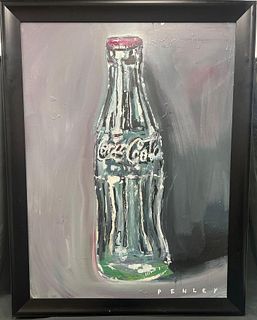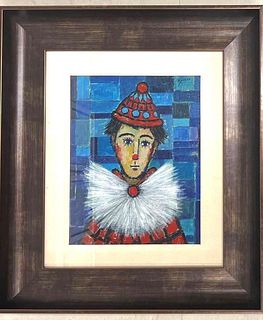Flemish school from the second third of the 16th century. Follower of AMBROSIUS BENSON (Lombardy Region ?, c. 1490-1500 - Bruges, 1550)."Virgin of th
Lot 71
About Seller
Setdart Auction House
Carrer Aragó 346
Barcelona
Spain
Setdart Subastas was born in 2004 and is currently the first online art auction in Spain with solidity, prestige and reliability guaranteed by our more than 60,000 users. Setdart has a young, dynamic and enterprising team ready to successfully manage the purchase and sale of art works through custom...Read more
Estimate:
EUR€6,000 - EUR€8,000
$6,451.61 - $8,602.15
Absentee vs Live bid
Two ways to bid:
- Leave a max absentee bid and the platform will bid on your behalf up to your maximum bid during the live auction.
- Bid live during the auction and your bids will be submitted real-time to the auctioneer.
Bid Increments
| Price | Bid Increment |
|---|---|
| EUR€0 | EUR€10 |
| EUR€200 | EUR€25 |
| EUR€500 | EUR€50 |
| EUR€1,000 | EUR€100 |
| EUR€3,000 | EUR€200 |
| EUR€5,000 | EUR€500 |
| EUR€10,000 | EUR€1,000 |
| EUR€20,000 | EUR€2,000 |
| EUR€50,000 | EUR€5,000 |
About Auction
By Setdart Auction House
Jun 1, 2021
Set Reminder
2021-06-01 09:45:00
2021-06-01 09:45:00
America/New_York
Bidsquare
Bidsquare : OLD MASTERS & SCULPTURE - Day 2
https://www.bidsquare.com/auctions/setdart-auction-house/old-masters-sculpture---day-2-6999
Setdart Auction House sofia@setdart.com
Setdart Auction House sofia@setdart.com
- Lot Description
Flemish school from the second third of the 16th century. Follower of AMBROSIUS BENSON (Lombardy Region ?, c. 1490-1500 - Bruges, 1550). "Virgin of the milk". Oil on panel. With period frame inserted in a 20th century frame. Measurements: 8 x 7 cm; 25 x 25 cm (frame). The present work is part of the Flemish school of the second third of the 16th century, which, due to its technical characteristics, is presumably attributed to a painter who followed Ambrosius Benson. We see in this one the representation of the Virgin of the Milk. It is an invocation and an iconography of the Virgin Mary, in which she is represented in the act of breastfeeding the Baby Jesus. This representation has had several developments in sacred art, such as painting, sculpture and the particular iconography of the Orthodox Church. The representation of the Virgin suckling the infant Jesus is mentioned by Pope Gregory the Great, a mosaic with this representation probably dating from the 12th century is found on the façade of the Basilica of Santa Maria in Trastevere, although a few other examples from the early Middle Ages still survive. Ambrosius Benson was one of the so-called masters of the tradition, successor to Van der Goes, and evidenced the influence of Van Eyck, Van der Weyden and the Flemish Primitives in general. However, in his work we can appreciate features already typical of the 16th century, coming from Italy, such as the triangular composition that we see in this work. Originally from Lombardy, more Italian features can be appreciated in his painting. Benson was a painter of religious subjects and portraits, and trained with Gerard David in Bruges from 1518, the year in which he obtained citizenship there. However, he had problems with his master that ended in a judicial process, and in 1519 he appears already registered in the Painters' Guild as an independent master. From the following year there was a clear growth in his activity, and between 1522 and 1530 he rented between one and three stalls in the annual market to sell his paintings. Benson held high positions in the painters' guild, his works were valued at very high prices and he had several apprentices, including two of his sons, Willem and Jan. Although only two of his signed works are known ("Triptych of St. Anthony of Padua" in the Musées Royaux des Beaux-Arts in Belgium and "The Holy Family" in a private collection), and seven dated, based on stylistic criteria more than one hundred and fifty paintings have been attributed to him. Benson's workshop had an important production and, as was the case with Adriaen Isenbrandt's, his works were generally destined for the Iberian Peninsula market. As for his language, despite his affiliation to tradition, he formed, together with Isenbrandt and Jan Provost, the last generation of Bruges painters characterized by breaking with the Gothic tradition and introducing in their style the innovations of the Italian Renaissance. This influence can be appreciated at the plastic level and in effects such as monumentality, since their themes and compositions are generally still inscribed in the Flemish tradition. On the other hand, the variety of themes and formats that characterizes his production may be due to a workshop with numerous collaborators.
- Shipping Info
-
In-house shipping available. Please inquire at admin@setdart.com.
-
- Buyer's Premium



 EUR
EUR CAD
CAD AUD
AUD GBP
GBP MXN
MXN HKD
HKD CNY
CNY MYR
MYR SEK
SEK SGD
SGD CHF
CHF THB
THB















